RICK: I can’t believe it. My parents are dead.
NEIL: You think that’s bad?
RICK: Yes I do, actually; what’s it to you, pissface?
MIKE: Shut up, you’re ruining my holiday.
RICK: Ruining your holiday? What about my holiday? Both my parents are dead. The selfish bastards. I was going to spend the whole summer with them.
– The Young Ones, “Summer Holiday”
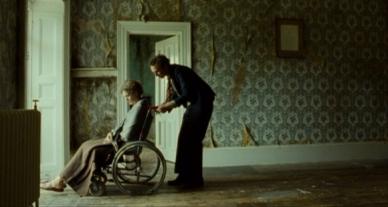 During one of his father’s regular business trips away from home, James was told that he was the “man of the house”, and this delicious phrase has lodged in his head. In contemporary England it’s as meaningless a mantle as that of “marquess” or “lord” – every man is a king in his own castle, but rules over nothing at all, not even his own heart.
During one of his father’s regular business trips away from home, James was told that he was the “man of the house”, and this delicious phrase has lodged in his head. In contemporary England it’s as meaningless a mantle as that of “marquess” or “lord” – every man is a king in his own castle, but rules over nothing at all, not even his own heart.
Longleigh House, pronounced “lonely house” by its Lord Donald, is being slowly disembowelled as its debts mount. The basic necessities remain, and the camera peers at the players from the edge of the room, giving each living space the feel of a proscenium theatre. Glimpses of a warmer, more financially and spiritually affluent past, traces of which have endured into the uncertain purgatory of the present, give the film its soul. Donald and his wife Nancy are reserved but tender parents to the histrionic James. Although their affection and loyalty towards him are unmistakable and moving, they are both inept in communicating with him and handling his tantrums; there is a Beckettian dislocation between the family members. James’ mental illness isn’t just a dramatic conceit – it allows him to personify the rage and terror of any child who has truly realised that his mother and father are not immortal. Leo Bill was cast in this role for his peculiar beauty, mingling the twisted caricatures of Gillray with the solemn delicacy of a Vermeer, as well as for his ability to channel Rik Mayall and Verruca Salt without compromising the character’s integrity.
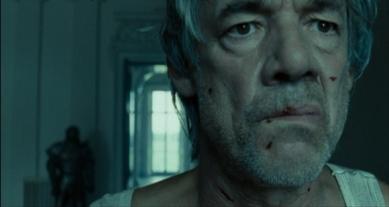 James is never allowed to leave the house, and so key events take place inside the 250 room mansion, in sequences that might be lifted from his childish fever dreams. When the emergency services are summoned to attend to Nancy, a fleet of cars and ambulances beetle down the drive like Dinky toys, and the surgeons tumble forth. They become stage hands in their own theatre, setting up in the hall where the operation unfolds frantically, in flashes of fractured speculation. Now that we have stepped through the looking glass of James’ chemically altered reality, the narrative has become so unreliable that we share his disbelief and confusion at his mother’s miracle recovery.
James is never allowed to leave the house, and so key events take place inside the 250 room mansion, in sequences that might be lifted from his childish fever dreams. When the emergency services are summoned to attend to Nancy, a fleet of cars and ambulances beetle down the drive like Dinky toys, and the surgeons tumble forth. They become stage hands in their own theatre, setting up in the hall where the operation unfolds frantically, in flashes of fractured speculation. Now that we have stepped through the looking glass of James’ chemically altered reality, the narrative has become so unreliable that we share his disbelief and confusion at his mother’s miracle recovery.
The panorama and paranoia of THE LIVING AND THE DEAD are unique in that they betray an affinity for the stylistic quirks and unhinged baroque of contemporary Korean cinematography found in films such as OLDBOY and GOZU – and yet we are dealing with a very English portrayal of social anachronism and solipsistic reserve. The time-cuts to Lord Donald’s future self feel at first jarring and extraneous, trapping the gently crafted character in a glib and apocryphal destiny. However, as they reach a crescendo of frantic match cuts between father, son and the downward spiral of the staircase, these future shocks offer themselves as a realistic projection of James’ own fate, should his stubborn fantasy of taking his father’s place as “the man of the house” be fulfilled.
The dramatic dissolution of THE LIVING AND THE DEAD brings to mind the early works of Polanski, in that it paints a pessimistic picture of the human condition without directly criticising the culture that produces these poor puppets. So, how to pigeonhole this one? Portal described the audience reaction to THE LIVING AND THE DEAD at several genre and non-genre festivals. The general consensus was that this is and isn’t a horror film. It was disturbing, certainly but not in a way that could easily be classified. This dichotomy had Rumley fired up to explore the avenue further. Portal describes RED, WHITE AND BLUE as a “slow-percolator”. He attends every screening and notes the way that the audience won’t applaud, won’t hang around to ask questions. However, the ensuing online buzz is always animated, often greatly admiring. Rumley’s intention, he says, is for the audience to be “thrust into shit” with “no time to accustomise”, and the online feedback from audience members is often far more lively and openly appreciative than the stunned silence and shell-shocked Q&A following a screening.
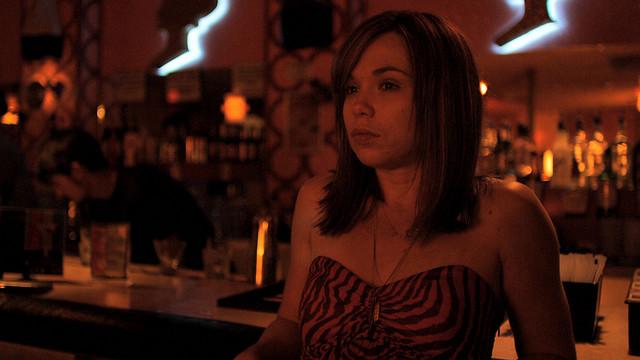
RED, WHITE AND BLUE continues the theme of pure, unconditional love and the lengths man will go to if he would keep it; and how he must avenge its loss. The story also strips the 80s vampire metaphor back to its roots, mingling the raging fatalism of Hubert Selby Junior with the visceral sensuality of Poppy Z Brite. This resurrection of the “don’t die of ignorance” theme resonates beyond sexual promiscuity and into the futility of war, personified by Noah Taylor as the Iraqi war veteran Nate. Taylor is a powerful and versatile performer, and he brings to RED, WHITE AND BLUE the blowtorch intensity of Charlie Manson and the internalised sexuality of Schiele’s wanker, in both style and spirit.
The colour and staging of RED, WHITE AND BLUE, its nail biting love scenes and prowling explorations of man’s underbelly are drawn straight from Peckinpah’s El Paso; and Richard Chester’s poignant tricks of soundtrack evoke Quincy Jones’ score from “The Getaway”, a film cited by Rumley as a direct influence. Critics frequently describe the film as unflinching, and yet one of its outstanding quirks of camerawork is the way that the camera does flinch, from almost every violent act or scene – in fact, it can’t even bear to glance at some of them, clasping the nearest face in closeup and letting the scene play out across their features. One online review describes the characters, without naming them, as “the victim, the aggressor and the avenger”. It’s genuinely impossible to tell which is which. I commented on the portrayal of women in this and Rumley’s short film “BITCH”. “Do you think he’s misogynistic?” Portal asked me, in a jolly sort of way. “No, not at all,” I replied. As a storyteller, Rumley shows us that anyone can be a villain, anyone can be a victim, regardless of gender. Scratch an abuser and you’ll find the abused. Violence runs in endless cycles, on a small or grand scale – and Nate’s Iraqi experience isn’t just a throwaway. Portal explained that George Bush’s “Mission Accomplished” speech in 2003 was a great driver behind this fierce vein to the film’s mythology. Rumley has a similar moral approach to his peer Jack Ketchum, whose film THE LOST he greatly enjoyed, not least because it introduced him to the excellent Marc Senter – who he cast as “Franki” in RED, WHITE AND BLUE. Senter is an extremely immersive and earnest actor whose role models include Robert De Niro and Dustin Hoffman. As “Franki” he more resembles a human answer to Christian Bale.
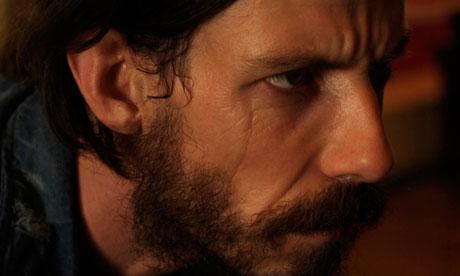
Rumley repeatedly refers to a key plot device in RED, WHITE AND BLUE as “the twist”, and is surprised when I point out that the device in question hadn’t come as a surprise to me at all – whereas the film had consistently knocked me for six in completely different places. One person might be most upset by the scenes of violence – for me, the most disturbing scenes were those depicting furious, Screaming Pope style mental breakdown. You may choose your own twist in this adventure: any character might surprise you with a change of heart or an irreversible moral flip – and each revelation will stretch your imagination, not your credulity. In the mid-sixties Alfred Hitchcock was seen as nothing more than a light entertainer, and critics were on the whole dismissive and disrespectful towards films which are now seen as rich matter for psychological and artistic analysis. Pioneers in art take leaps of faith which leave lacunas, but each dropped stitch is our cue to explore the unspoken and the unseen. In order to earn our trust, a filmmaker must show that he trusts his audience to read between the lines.
“Major combat operations in Iraq have ended. In the battle of Iraq, the United States and our allies have prevailed.”
–President Bush, standing under a “Mission Accomplished” banner on the USS Lincoln aircraft carrier, May 2, 2003

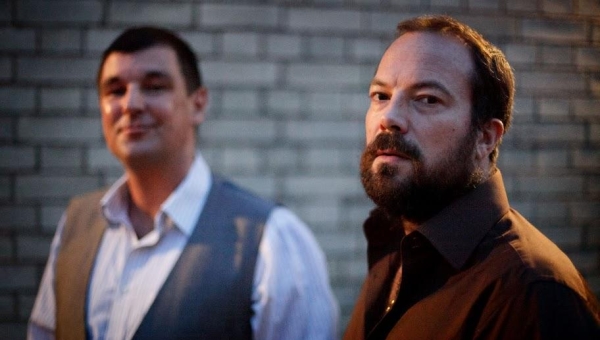
3 thoughts on “Simon Rumley Talks to Take One”
Comments are closed.